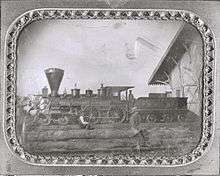Gasconade Bridge train disaster

The Gasconade Bridge train disaster was a rail accident at Gasconade, Missouri on November 1, 1855.
At the time of the disaster, the Pacific Railroad was being built west from St. Louis toward the Pacific Ocean. St. Louis was to be the starting point for a transcontinental railroad, an effort led by Senator Thomas Hart Benton of Missouri.[1] In 1851, construction began on the railroad, and two years later, it had reached Kirkwood, Missouri. In 1855, the railroad had been completed to Jefferson City. The railroad bridge over the Gasconade River was unfinished, but was supported by temporary trestle.[1]
On November 1 on a day of rain, an inaugural train carrying some 600 invited visitors and dignitaries, including Henry Chouteau, of the founding family of St. Louis, set out from downtown at 9 a.m. led by the locomotive "Missouri." Thomas O'Sullivan was chief engineer on the train.[1] O'Sullivan considered stopping to check the Gasconade bridge, but felt reassured of its stability, as a gravel-hauling train had traveled over it the day before. As the train started to pass over the Gasconade Bridge, a 760-foot wooden structure spanning the Gasconade River, the span between the bank and the first pier collapsed. The engine and all but one of the 15 cars fell off the tracks, some going through the broken wooden timbers, and others rolling down the bank into the river. Thirty-one people were killed, including Chouteau, O'Sullivan, and many other prominent St. Louis citizens. Seventy other passengers were seriously injured. While a conductor attempted to telegraph for help in nearby Hermann, the storm had disabled the telegraph lines and first word of the disaster did not reach St. Louis until 8 p.m., some 7 hours after the bridge collapse.[1] The Missouri Republican from November 2, 1855 contained stories on both the inaugural trip of the Pacific Railroad and the ensuing tragedy. On the former topic, the article ends "How little do we know what an hour may bring forth! The above paragraphs had hardly been written when reports came of a terrible disaster in an attempt to cross the Gasconade Bridge. At a later hour, we received the melancholy particulars which are detailed in another article."[2] The follow up article contained the names of the dead and seriously injured. Others were less severely injured, but the paper did not name them.[2]
The storm also affected a temporary trestle near Washington, Missouri, so survivors and deceased had to be transported to Washington via steamboat and were not returned to St. Louis until November 3. The city was shut down to accommodate the funerals.[1] Many of the dead were buried at Bellefontaine Cemetery in St. Louis.
A Pacific train did eventually reach Jefferson City four months later, but St. Louis' plan of being the starting point of the transcontinental railroad was unsuccessful. In 1869, the transcontinental railroad was completed with the Golden Spike in Utah. The railroad stretched from San Francisco to Chicago. The Pacific Railroad was renamed Missouri Pacific in 1867 and later became Union Pacific, in 1982. [1]
References
- 1 2 3 4 5 6 O'Neil, Tim (November 4, 2012). "Look Back: Disaster at bridge in 1855 derails St. Louis dream for a transcontinental railroad". Retrieved February 9, 2016.
- 1 2 "St. Louis Daily Missouri Republican, 1854-1860". November 2, 1855. Retrieved February 9, 2016.
|first1=missing|last1=in Authors list (help)
Information not specifically attributed comes from:
- Bob Aubuchon. "Remembering the Gasconade Disaster". Central Pacific Railroad Photographic History Museum. Retrieved 2008-08-22.
Coordinates: 38°40′09″N 91°33′12″W / 38.669211°N 91.553278°W